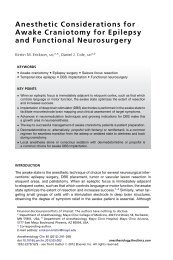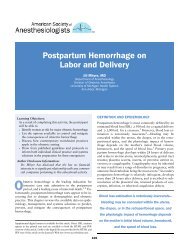A Fire in the Operating Room: It Could Happen to You! - Vtr
A Fire in the Operating Room: It Could Happen to You! - Vtr
A Fire in the Operating Room: It Could Happen to You! - Vtr
You also want an ePaper? Increase the reach of your titles
YUMPU automatically turns print PDFs into web optimized ePapers that Google loves.
A<strong>Fire</strong><strong>in</strong><strong>the</strong>Operat<strong>in</strong>g<strong>Room</strong><br />
<strong>to</strong> enter <strong>the</strong> trachea. This is an extremely risky practice and<br />
it is far better <strong>to</strong> use a knife or scissors. The surgeon may<br />
request that <strong>the</strong> FiO 2 be decreased, but this can take several<br />
m<strong>in</strong>utes because of <strong>the</strong> volume of <strong>the</strong> anes<strong>the</strong>sia circuit.<br />
Also, many of <strong>the</strong>se patients are on high oxygen concentrations<br />
and will not <strong>to</strong>lerate even a brief decrease <strong>in</strong> FiO2.<br />
There has already been a death reported <strong>in</strong> Japan related <strong>to</strong><br />
us<strong>in</strong>g <strong>the</strong> ESU dur<strong>in</strong>g a tracheos<strong>to</strong>my.<br />
Ano<strong>the</strong>r example of a fire <strong>in</strong> <strong>the</strong> patient occurred when a<br />
child was hav<strong>in</strong>g a <strong>to</strong>nsillec<strong>to</strong>my. 13 The anes<strong>the</strong>siologist<br />
was adm<strong>in</strong>ister<strong>in</strong>g 70% N 2O and 30% O 2 through an<br />
uncuffed endotracheal tube. The O2/N2O leaked out<br />
around <strong>the</strong> tube, and while <strong>the</strong> surgeon was us<strong>in</strong>g <strong>the</strong> ESU,<br />
sparks and a fire occurred. Clearly, a lower FiO2, a cuffed<br />
endotracheal tube, or seal<strong>in</strong>g <strong>the</strong> airway with sal<strong>in</strong>esoaked<br />
pledgets would have prevented this problem.<br />
N2O could be <strong>the</strong> oxidizer for a fire dur<strong>in</strong>g laparoscopic<br />
surgery. Because bowel gas may conta<strong>in</strong> very high levels of<br />
methane or hydrogen, and because N 2O will diffuse <strong>in</strong><strong>to</strong><br />
<strong>the</strong> peri<strong>to</strong>neum, if <strong>the</strong> surgeon accidentally enters <strong>the</strong><br />
bowel, <strong>the</strong>n <strong>the</strong> ESU could ignite <strong>the</strong> methane or hydrogen.<br />
Greilich 20 reported an <strong>in</strong>traoperative fire that occurred<br />
when a tank conta<strong>in</strong><strong>in</strong>g both O2 and CO2 was accidentally<br />
used <strong>to</strong> <strong>in</strong>flate <strong>the</strong> abdomen <strong>in</strong>stead of 100% CO2.<br />
Absorbents<br />
Desiccated CO 2 absorbent has been reported <strong>to</strong> be <strong>the</strong><br />
source of several OR fires. 21–24 The desiccated absorbent<br />
was composed of monovalent bases (KOH and NaOH)<br />
and reacted with sevoflorane <strong>to</strong> produce very high temperatures.<br />
This was a particular problem with <strong>the</strong> Baralymet<br />
brand of CO2 absorbent. In a labora<strong>to</strong>ry experiment,<br />
Laster et al. 25 showed that sevoflurane produced susta<strong>in</strong>ed<br />
temperatures greater than 2001C, whereas with isoflurane<br />
and desflurane <strong>the</strong> temperatures never exceeded 1001C<br />
and had a rapid decay. Several canister fires were reported<br />
before Baralyme was removed from <strong>the</strong> market. A newer<br />
absorbent called Amsorbt conta<strong>in</strong>s calcium hydroxide<br />
[Ca(OH2)], has no monovalent bases, and does not break<br />
down any of <strong>the</strong> <strong>in</strong>halation anes<strong>the</strong>tic agents. 26<br />
Oxygen<br />
Currently, <strong>the</strong> majority of OR fires occur with moni<strong>to</strong>red<br />
anes<strong>the</strong>sia care dur<strong>in</strong>g head and neck surgery. Invariably,<br />
this <strong>in</strong>volves an oxygen-enriched atmosphere s<strong>in</strong>ce 75% of<br />
surgical fires are oxygen enriched (Supplemental Digital<br />
Content 2, http://l<strong>in</strong>ks.lww.com/ASA/A245). Currently, <strong>the</strong><br />
Anes<strong>the</strong>sia Patient Safety Foundation recommends that <strong>the</strong>re<br />
be no open delivery of oxygen dur<strong>in</strong>g <strong>the</strong>se cases 27 (Supplemental<br />
Digital Content 3, http://l<strong>in</strong>ks.lww.com/ASA/A246). If<br />
<strong>the</strong> patient needs <strong>in</strong>creased levels of sedation dur<strong>in</strong>g a time<br />
when <strong>the</strong> surgeon is us<strong>in</strong>g <strong>the</strong> ESU or laser, <strong>the</strong>n <strong>the</strong> airway<br />
needs <strong>to</strong> be secured with a laryngeal mask airway or an endotracheal<br />
tube. Occasionally <strong>the</strong>re are exceptional cases <strong>in</strong><br />
which <strong>the</strong> patient and <strong>the</strong> anes<strong>the</strong>siologist need <strong>to</strong> communicate,<br />
such as dur<strong>in</strong>g a carotid endarterec<strong>to</strong>my or an awake<br />
cranio<strong>to</strong>my. In <strong>the</strong>se <strong>in</strong>stances, it may be safe <strong>to</strong> use an FiO2<br />
up <strong>to</strong> 30%. Preferably <strong>the</strong> patient should receive only room<br />
air dur<strong>in</strong>g <strong>the</strong>se cases.<br />
Currently, <strong>the</strong> majority of OR fires occur<br />
with moni<strong>to</strong>red anes<strong>the</strong>sia care dur<strong>in</strong>g<br />
head and neck surgery.<br />
Air can be delivered from <strong>the</strong> anes<strong>the</strong>sia mach<strong>in</strong>e or<br />
from an air/oxygen blender. There are several ways <strong>to</strong> deliver<br />
air <strong>to</strong> a nasal cannula or a face mask. The simplest is<br />
<strong>to</strong> put a small endotracheal tube connec<strong>to</strong>r <strong>in</strong><strong>to</strong> <strong>the</strong> end of<br />
<strong>the</strong> Y-piece on <strong>the</strong> circle system and completely close <strong>the</strong><br />
adjustable pressure relief valve. If oxygen must be used, <strong>the</strong><br />
anes<strong>the</strong>siologist should start with air and <strong>the</strong>n slowly add<br />
oxygen while keep<strong>in</strong>g <strong>the</strong> FiO 2 at less than 30% (Supplemental<br />
Digital Content 4, http://l<strong>in</strong>ks.lww.com/ASA/A247).<br />
If <strong>the</strong> oxygen concentration exceeds 30%, <strong>the</strong>n several m<strong>in</strong>utes<br />
must be allowed for oxygen <strong>to</strong> wash out before <strong>the</strong><br />
surgeon uses <strong>the</strong> ESU. Oxygen should be diluted with 5 <strong>to</strong><br />
10 L/m<strong>in</strong> of air next <strong>to</strong> <strong>the</strong> patient; open drap<strong>in</strong>g with an<br />
<strong>in</strong>cise drape can also be helpful. <strong>It</strong> should be remembered<br />
that 30% O 2 is achieved by add<strong>in</strong>g 0.2 L/m<strong>in</strong> of O 2 <strong>to</strong> 1.8 L/<br />
m<strong>in</strong> of air. Also, on some mach<strong>in</strong>es, such as <strong>the</strong> GE-Ohmeda<br />
Aestiva, <strong>the</strong>re is an alternate fresh gas outlet. By activat<strong>in</strong>g<br />
<strong>the</strong> lever next <strong>to</strong> <strong>the</strong> CO2 canister, a nasal cannula can be<br />
attached <strong>to</strong> <strong>the</strong> outlet via a small endotracheal tube connec<strong>to</strong>r<br />
(Figure 6). This is preferable <strong>to</strong> us<strong>in</strong>g <strong>the</strong> circle system<br />
as it greatly decreases <strong>the</strong> dead space of <strong>the</strong> system.<br />
PREPPING SOLUTIONS<br />
Ano<strong>the</strong>r extremely dangerous situation is when <strong>the</strong> surgeon<br />
uses a volatile prepp<strong>in</strong>g solution (Figure 7). Dura-<br />
Prept is one such commonly used solution and it conta<strong>in</strong>s<br />
74% alcohol. Alcohol, especially <strong>in</strong> an oxygen-enriched<br />
FIGURE 6. A nasal cannula connected <strong>to</strong> <strong>the</strong> alternate fresh gas outlet on a<br />
GE-Datex-Ohmeda Aestiva anes<strong>the</strong>sia mach<strong>in</strong>e.<br />
29




